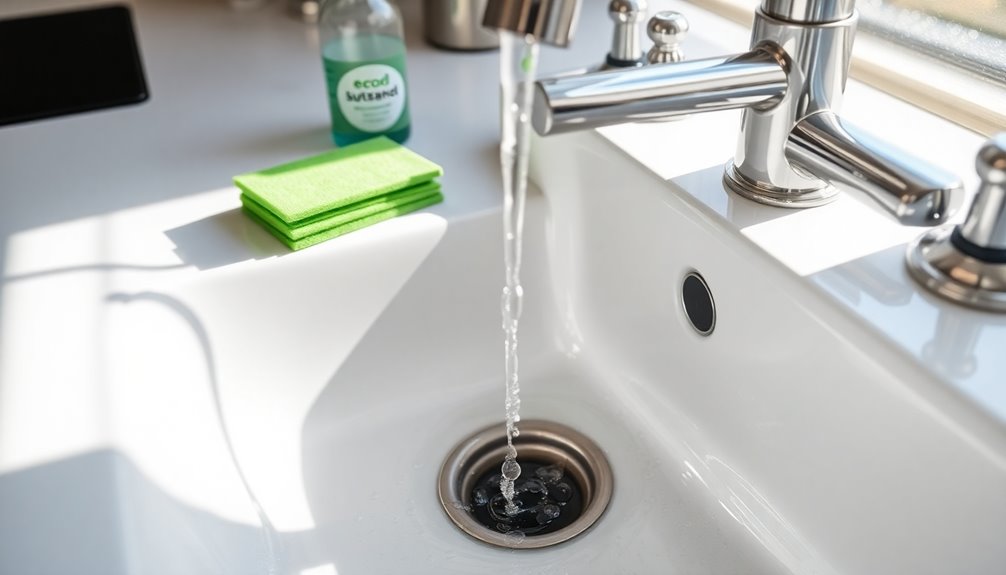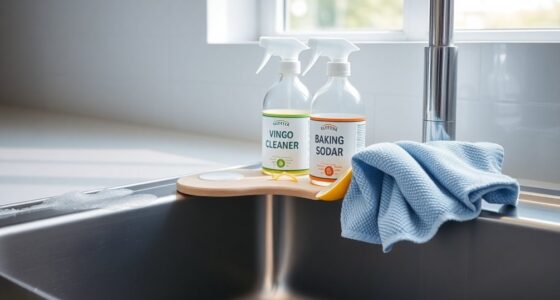To clean your sink's overflow hole, first, use a pipe cleaner or sink brush to remove any buildup. Then, boil 2-3 quarts of water, and carefully pour it down the overflow using a silicone funnel. For a deeper clean, add 1 cup of baking soda followed by 1 cup of distilled white vinegar, letting it fizz for 15 minutes. Finally, flush with more boiling water. Keep your overflow clean to prevent issues, and stick around to discover more tips.
Key Takeaways
- Use a sink-cleaning brush or pipe cleaner to remove buildup from the overflow hole.
- Pour 2-3 quarts of boiling water into the overflow using a silicone funnel.
- Deodorize by adding 1 cup of baking soda followed by 1 cup of distilled white vinegar.
- Let the baking soda and vinegar fizz for 15 minutes for a deeper clean.
- Regularly clean the overflow hole at least once a month to prevent odors and clogs.
Understanding the Purpose of the Overflow Hole

When you think about your sink, you mightn't consider the overflow hole, but it plays an important role in preventing water from spilling over. This small opening is designed to divert excess water, giving you a significant moment to react if the sink's faucet is accidentally left on or if there's a plumbing issue.
Keeping this overflow hole clean is essential for maintaining ideal drainage and ensuring effective water flow. A blocked overflow can lead to unpleasant odors, mold, and mildew, compromising your bathroom hygiene.
Regularly checking and cleaning the overflow hole not only enhances your sink's functionality but also protects surrounding areas from potential water damage. So, don't overlook this important feature!
Importance of Regularly Cleaning the Overflow Hole
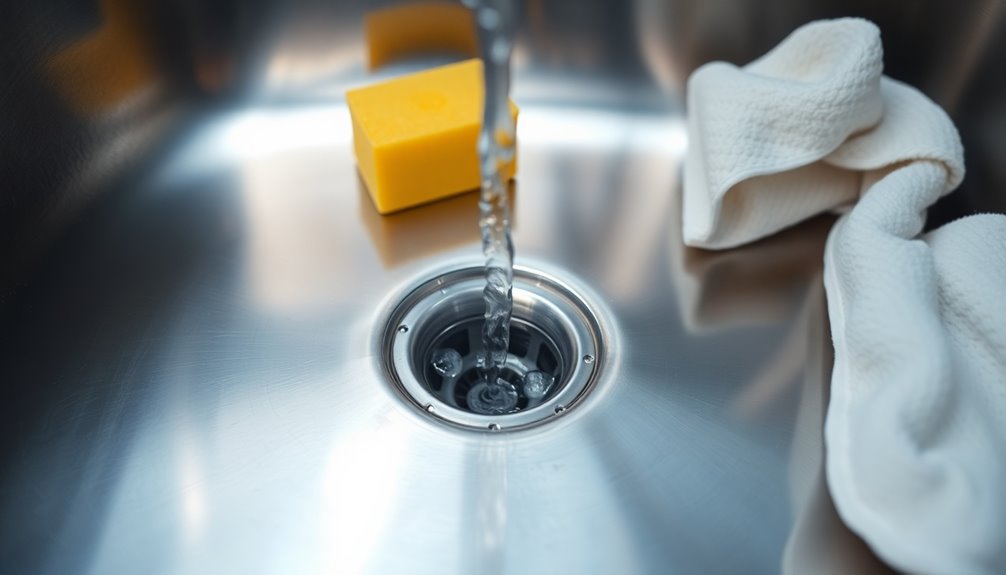
Cleaning your sink's overflow hole regularly is essential for preventing mildew and mold growth.
When you keep it clear, you guarantee ideal drainage flow, which helps your sink function properly.
Don't overlook this simple maintenance task; it can save you from bigger issues down the line.
Prevent Mildew and Mold
Regular maintenance of your sink's overflow hole is essential, as neglecting it can lead to the buildup of organic materials that promote mildew and mold growth.
To keep your bathroom healthy, make it a habit to clean and clear the overflow drain regularly. A blocked overflow hole traps moisture, creating the perfect environment for mold and mildew to thrive, which can negatively impact your indoor air quality.
By frequently cleaning this area, you minimize moisture retention, greatly reducing the chances of unwanted mildew and mold. This practice not only contributes to overall bathroom hygiene but also helps to eliminate unpleasant odors, resulting in a more pleasant living space for you and your family.
Invest time in this simple task for lasting benefits.
Ensure Optimal Drainage Flow
To guarantee ideal drainage flow, it's crucial to keep your sink's overflow hole clean and clear. Regularly cleaning the overflow hole prevents blockages that can hinder its ability to divert excess water, ensuring optimal drainage.
A clear overflow hole allows water to flow freely, minimizing the risk of backflow or pooling. Additionally, routine maintenance helps eliminate mildew and mold, contributing to better bathroom hygiene and air quality.
Neglecting this area can lead to unpleasant odors, as trapped debris and stagnant water create a breeding ground for bacteria. By keeping the overflow hole clean, you not only enhance your sink's functionality but also protect surrounding areas from potential water damage due to overflow incidents.
Essential Tools for Cleaning the Sink Overflow
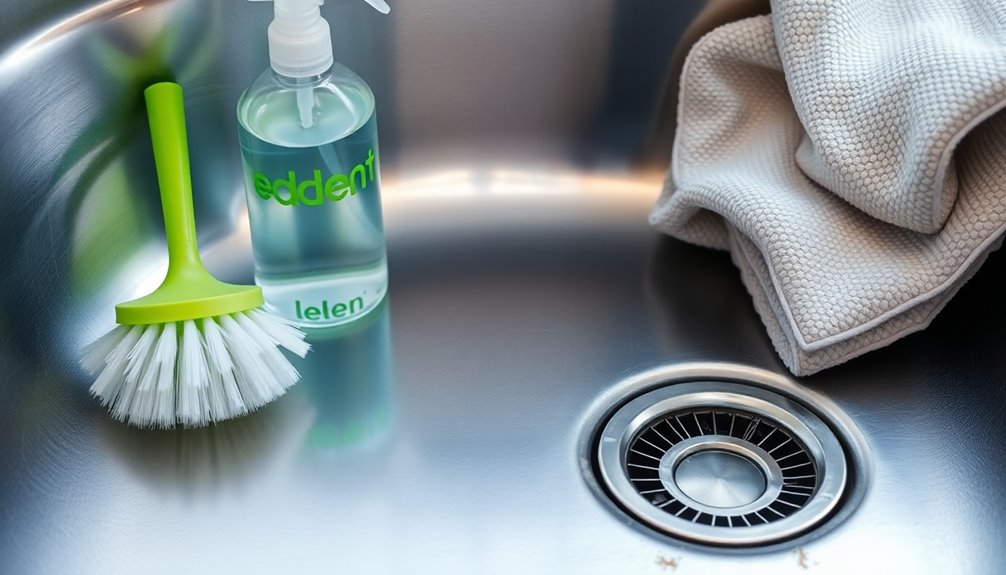
While you mightn't think about it often, having the right tools can make cleaning your sink overflow much easier. A sink-cleaning brush or pipe cleaner is essential for effectively removing buildup from the sink overflow hole.
You'll also need a silicone funnel, which allows you to safely pour boiling water into the overflow without risking burns or spills. Aim for about 2-3 quarts of boiling water to flush out debris and guarantee a thorough cleaning.
Optional supplies like baking soda and distilled white vinegar can help deodorize any lingering odors. Remember to employ safety precautions, like having a helper when handling boiling water, to prevent accidents during the cleaning process.
Step-by-Step Guide to Cleaning the Overflow Hole
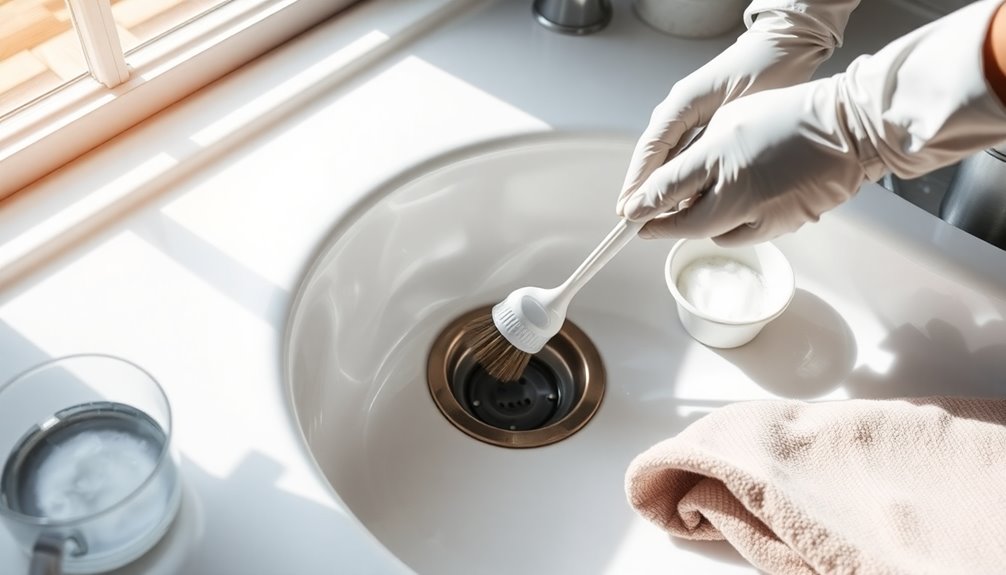
With the right tools in hand, you're ready to tackle the task of cleaning your sink overflow hole.
Start by inserting a pipe cleaner or sink cleaning brush into the overflow hole, moving it in and out to remove any gunk and buildup.
Next, boil 2-3 quarts of water and use a silicone funnel to carefully pour it into the overflow hole, flushing out debris.
For a deeper clean, add 1 cup of baking soda followed by 1 cup of distilled white vinegar into the funnel. Allow the mixture to fizz and sit for 15 minutes.
Afterward, repeat the boiling water flush to verify any remaining buildup is cleared.
Regular cleaning keeps your overflow hole functioning efficiently and prevents clogs.
How to Address Odors in the Overflow Drain
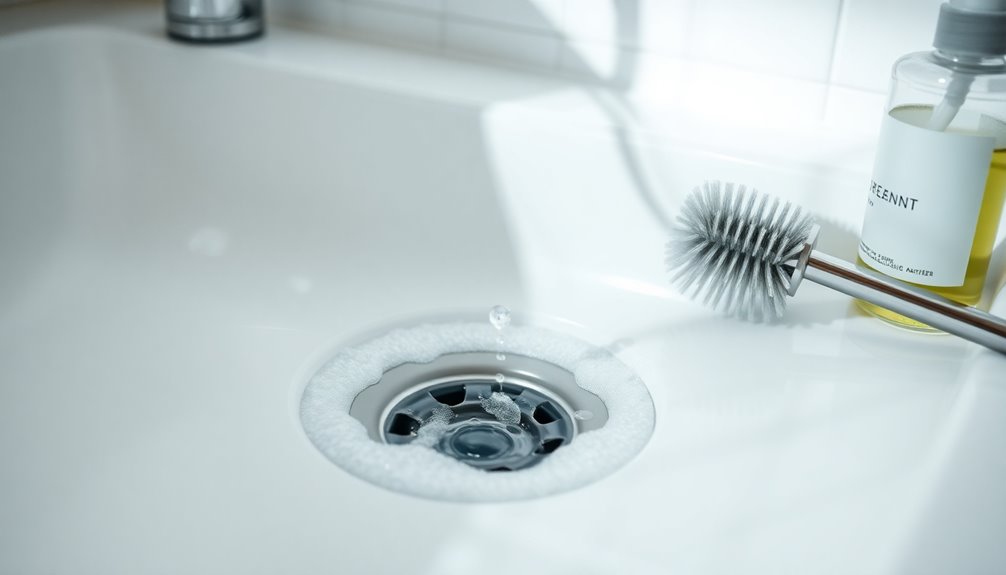
Have you ever noticed unpleasant odors wafting from your sink's overflow drain? To tackle this issue, start by pouring 1 cup of baking soda into the overflow hole using a silicone funnel to minimize spillage.
Next, add 1 cup of distilled white vinegar. This combination creates a foaming action that helps break down buildup and eliminate odors. Let the mixture sit for about 15 minutes for maximum deodorizing effect.
After the waiting period, flush the overflow hole with 2-3 quarts of boiling water to rinse away any remaining debris and odors.
Regularly using this method can prevent unpleasant smells and keep your sink environment fresh. So don't wait—get started and enjoy a cleaner, odor-free sink!
Tips for Maintaining a Clean Overflow Hole

To keep your sink's overflow hole clean, establish a regular cleaning schedule to prevent buildup.
Make sure you use the right tools, like a pipe cleaner or a sink brush, to effectively tackle any gunk.
Staying proactive will help you avoid unpleasant odors and clogs down the line.
Regular Cleaning Schedule
Cleaning your sink overflow hole at least once a month is essential for preventing buildup and ensuring peak functionality.
To keep your sink in top shape, quickly inspect the overflow hole after each use for any visible debris and clean it immediately. Incorporating this task into your regular sink cleaning routine guarantees consistent attention.
If you notice unpleasant odors or slow drainage, act promptly with a deep cleaning using baking soda and vinegar.
To encourage regular maintenance, keep a pipe cleaner or sink cleaning brush handy near your sink. This way, you'll have easy access for quick clean-ups, helping to maintain a fresh, functional overflow hole in your sink.
Use Proper Tools
Maintaining a clean overflow hole requires the right tools to effectively tackle buildup and debris. Start with a pipe cleaner or sink-cleaning brush designed for this purpose. A silicone funnel is essential for safely pouring boiling water into the overflow without risking burns or spills. To flush the overflow hole, boil 2-3 quarts of water and use the funnel to pour it in, loosening any remaining gunk.
| Tool | Purpose |
|---|---|
| Pipe Cleaner | Removes buildup and debris |
| Sink-Cleaning Brush | Reaches deep into the overflow for cleaning |
| Silicone Funnel | Safely pours boiling water to flush |
Regularly cleaning with these tools can help prevent clogs, odors, and mold growth.
Troubleshooting Common Overflow Drain Issues
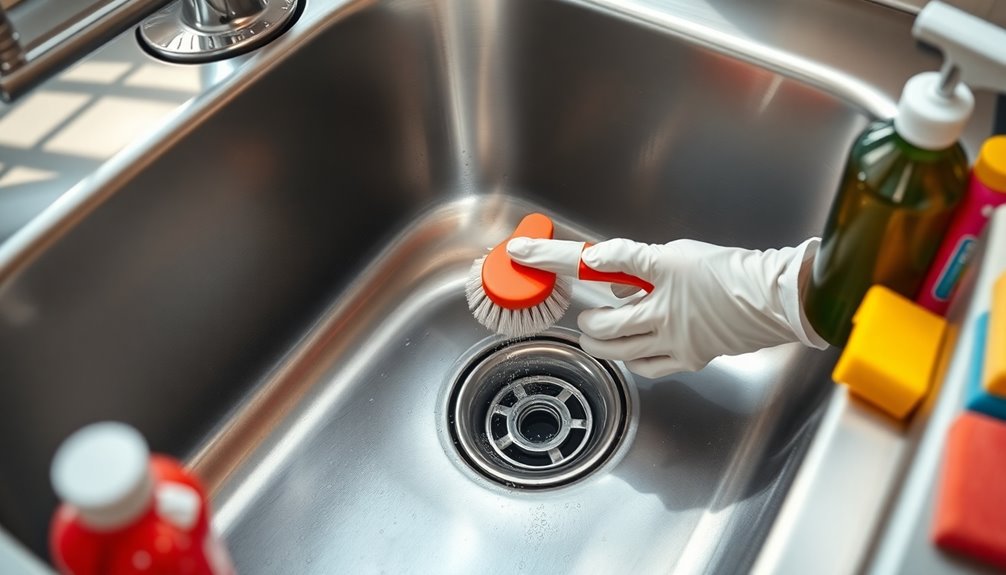
When you notice slow draining or standing water in your sink, it often signals a blockage in the overflow hole that needs your attention.
Start by inspecting the overflow hole for any visible debris. If you smell bad odors, it could mean buildup inside the drain. A mixture of baking soda and vinegar can effectively tackle this issue; pour it down the overflow hole, let it sit for a few minutes, and then flush it with boiling water.
Regularly cleaning the overflow hole prevents mildew and mold growth, keeping unpleasant smells at bay.
If you consistently find blockages despite your efforts, deeper plumbing issues might be at play, and it could be time to evaluate professional help.
When to Seek Professional Help for Clogs
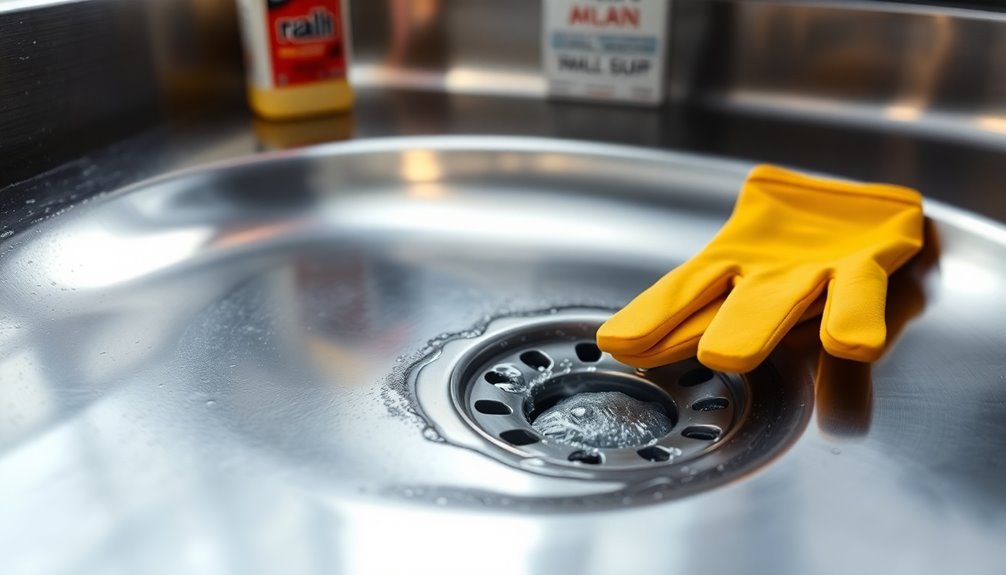
If you notice persistent odors or clogs that regular cleaning methods can't resolve, it might signal a deeper plumbing problem.
When the overflow hole is completely blocked and you can't clear it with a pipe cleaner or brush, a professional can use specialized tools to safely address the blockage.
If multiple sinks in your home are struggling to drain, it's a sign of a larger issue that needs expert intervention.
Recurring backups in the overflow, despite your cleaning efforts, also warrant a call to a plumber.
If you're uncomfortable with maintenance or lack the right tools, seeking professional help can prevent your sink from flooding. Additionally, understanding emergency fund management can provide financial reassurance while addressing unexpected plumbing costs.
Best Practices for Sink Maintenance
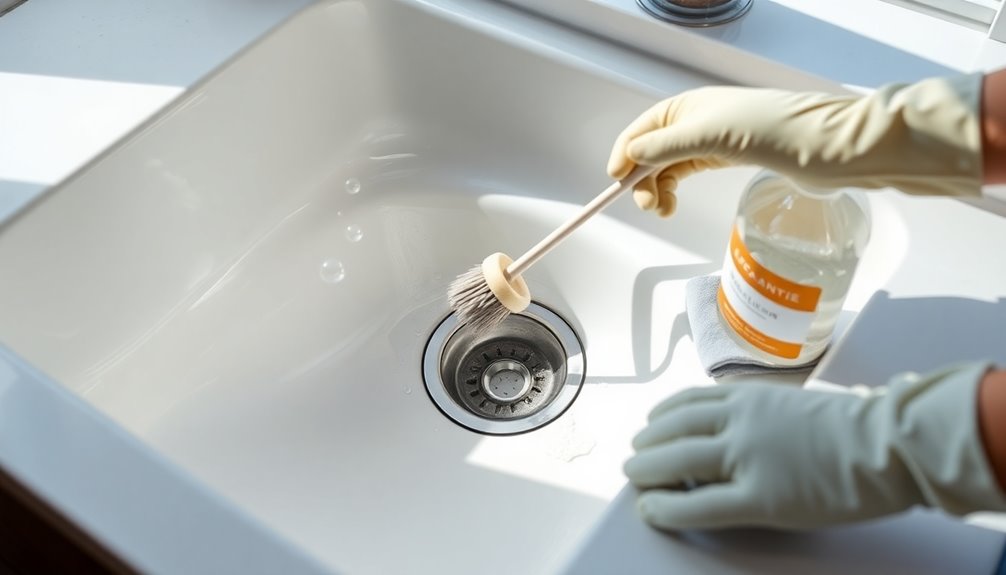
Regular maintenance of your sink can make a significant difference in its longevity and functionality.
Start by regularly cleaning the overflow hole during your routine sink cleaning sessions to prevent mildew, mold growth, and unpleasant odors. Use a pipe cleaner or sink-cleaning brush to eliminate buildup, ensuring peak drainage.
Every few months, flush the overflow hole with 2-3 quarts of boiling water to clear debris and maintain water flow efficiency. For stubborn gunk, pour a mixture of baking soda and distilled white vinegar down the overflow hole, letting it sit for 15 minutes before flushing with boiling water.
Finally, avoid letting water reach the overflow hole during regular use to minimize clogs and keep your sink area hygienic.
Related Resources and Further Reading
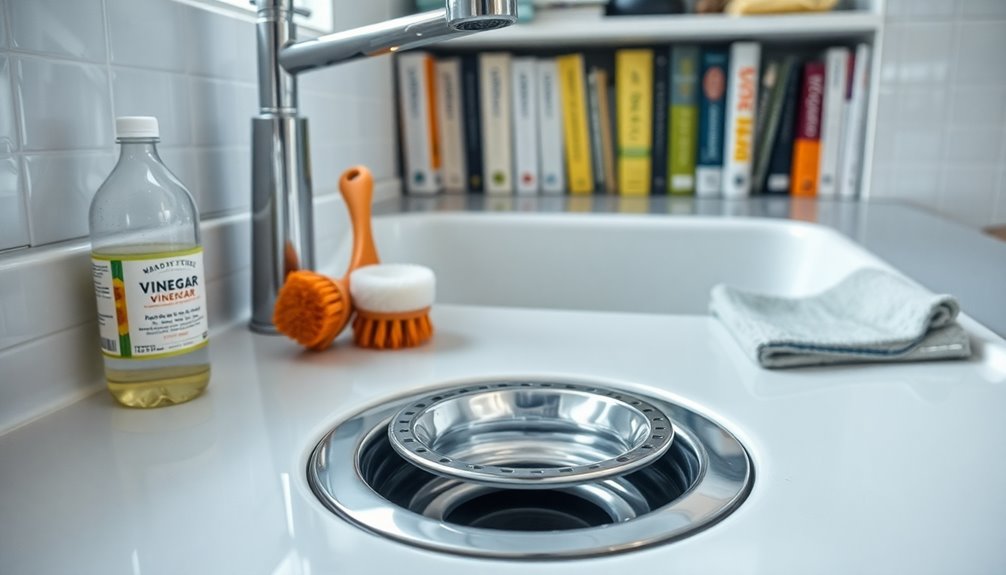
Maintaining your sink's overflow hole is just one part of keeping your entire sink in top shape. Regular cleaning is essential to remove as much gunk as possible and prevent odors. Here are some helpful resources to guide you:
| Resource Type | Title | Link |
|---|---|---|
| Article | Effective Sink Maintenance | [Read More] |
| Video Tutorial | Cleaning Overflow Holes | [Watch Now] |
| DIY Guide | Odor Neutralization Techniques | [Explore] |
| Professional Help | When to Call a Plumber | [Find Out] |
Make sure to flush the overflow hole with boiling water after cleaning and consider using baking soda and vinegar for deodorizing. Don't hesitate to reach out to a plumber if you encounter persistent issues.
Frequently Asked Questions
How Do You Clean the Overflow Hole in a Sink?
To clean the overflow hole in your sink, start by using a pipe cleaner or a sink cleaning brush.
Insert it into the hole and move it in and out to dislodge any gunk.
Next, boil 2-3 quarts of water and carefully pour it into the hole with a funnel.
For odors, add baking soda and vinegar, let it fizz, and then flush with boiling water.
Regular cleaning prevents mildew and guarantees proper drainage.
What Is the Black Gunk in My Sink Overflow?
That black gunk in your sink overflow is like a hidden monster lurking beneath the surface.
It's a mix of soap scum, hair, food particles, and mildew that builds up over time.
When water stagnates, this unsightly residue thrives, creating unpleasant odors and potential blockages.
If you ignore
How to Clean up Drain Overflow?
To clean up a drain overflow, start by using a pipe cleaner or sink brush to remove any buildup.
Next, boil a couple of quarts of water and carefully pour it into the overflow hole with a funnel to flush out debris.
For odors, mix one cup of baking soda with one cup of distilled white vinegar, let it fizz for 15 minutes, then follow with boiling water to clear everything out.
Regular maintenance helps prevent issues!
How Do I Get Rid of the Smell in My Sink Overflow?
To get rid of the smell in your sink overflow, start by pouring a cup of baking soda into the hole.
Then, follow it with a cup of distilled white vinegar.
Let the mixture sit for 10-15 minutes.
After that, flush it with 2-3 quarts of boiling water.
If the smell persists, repeat the process until you notice a difference, and keep up with regular maintenance to prevent future odors.
Conclusion
Cleaning your sink overflow is as essential as brushing your teeth—it keeps things fresh and prevents bigger problems down the line. By regularly maintaining this often-overlooked area, you can avoid unpleasant odors and clogs. Remember to use the right tools and techniques to guarantee a thorough clean. If you encounter persistent issues, don't hesitate to call in a professional. With a little effort, you can keep your sink in top shape, making your kitchen or bathroom a more pleasant space.
